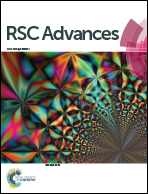Room-temperature hydrogen sensing performance of Nb2O5 nanorod arrays
Abstract
Nb2O5 nanorod arrays with a hexagonal phase were in situ grown on Nb foil via a facile hydrothermal method. The aspect ratio and spacing of the Nb2O5 nanorods increased upon an increase in the reaction temperature. A pair of platinum electrodes was deposited on the surface of the Nb2O5 nanorod arrays to form a hydrogen sensor. The sensor based on Nb2O5 nanorod arrays exhibited a fast and highly-sensitive hydrogen response with a sensitivity of 74.3% and a response time of 28 s toward 6000 ppm of H2 at room temperature. The Nb2O5 nanorod arrays also showed good selectivity of H2 against C2H6O, CO and NH3. The hydrogen sensing performance can be attributed to the reaction between chemisorbed oxygen species and H2. The Nb2O5 nanorods have a high aspect ratio, leading to an increase in the chemisorbed oxygen species on the surface of the [001] orientated nanorods. Moreover, arrays with a vertical structure have low quantities of junctions, which allow oxygen ions to diffuse more easily.



 Please wait while we load your content...
Please wait while we load your content...